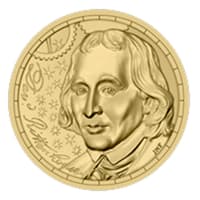
Jamie Franki, a faculty member in the Art + Art History Department in the College of Arts + Architecture, has designed the official medal for the American Numismatic Association (ANA) 121st anniversary convention.
The medal honors David Rittenhouse, first director of the U.S. Mint. According to the ANA, the piece celebrates Rittenhouse’s contributions to science and American coinage history. Largely self-educated, Rittenhouse is known for skills in astronomy and surveying.
Franki, a former master designer in the U.S. Mint’s Artistic Infusion Program, drafted the 2005 American Bison Nickel reverse and the face of the Jefferson 1800 Nickel in 2006. In 2008, his Order of Ikkos medallion was selected to be presented to the personal coaches of future U.S. Olympic/Paralympic medalists.
The ANA convention will be held in Philadelphia in August. Franki noted, “Philadelphia has a rich heritage, not only as the cradle of the American Revolution but also as the foundation of our nation’s coinage. I endeavored to tie aspects of these two ideas together in a unique way. The obverse features a portrait of Rittenhouse while the reverse is reminiscent of the rare 1792 half disme, one of the first issues of the newly established mint. Rittenhouse personally delivered specimens of the new coinage to Thomas Jefferson, and many were given to dignitaries as examples of minting excellence and American ideals. The stars, gears and markings along the obverse rim are derived from Rittenhouse’s orrery machines, devices he painstakingly constructed to create accurate maps of the solar system. Curved along the edge is a facsimile of the inventor’s signature. The reverse carries a single star, as does the reverse of the half disme. Since Philadelphia is the City of Brotherly Love, I placed an olive branch in the eagle’s beak as a sign of peace; 13 olives on the branch represent the original colonies. The typeface I used is called ‘Benjamin Franklin’ after the great Philadelphian who coincidentally created legends for the half dime and subsequently for the Fugio cent.”